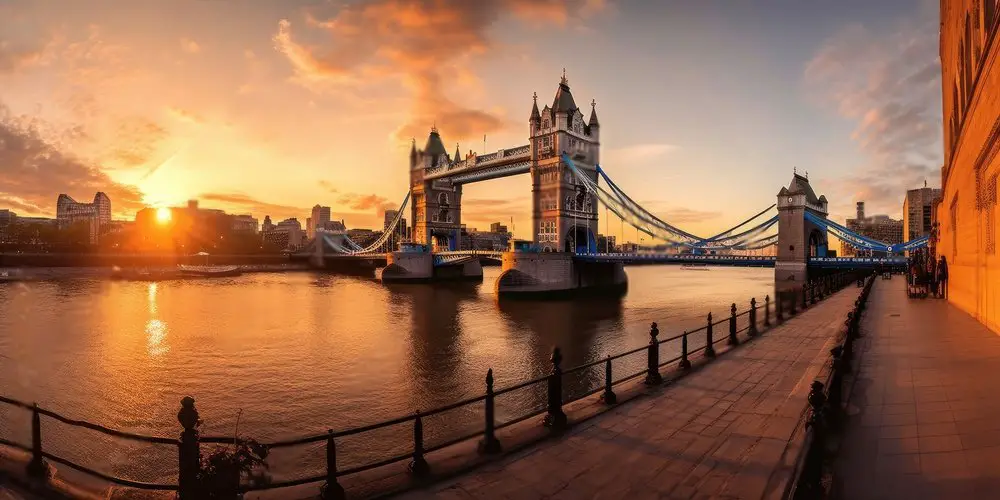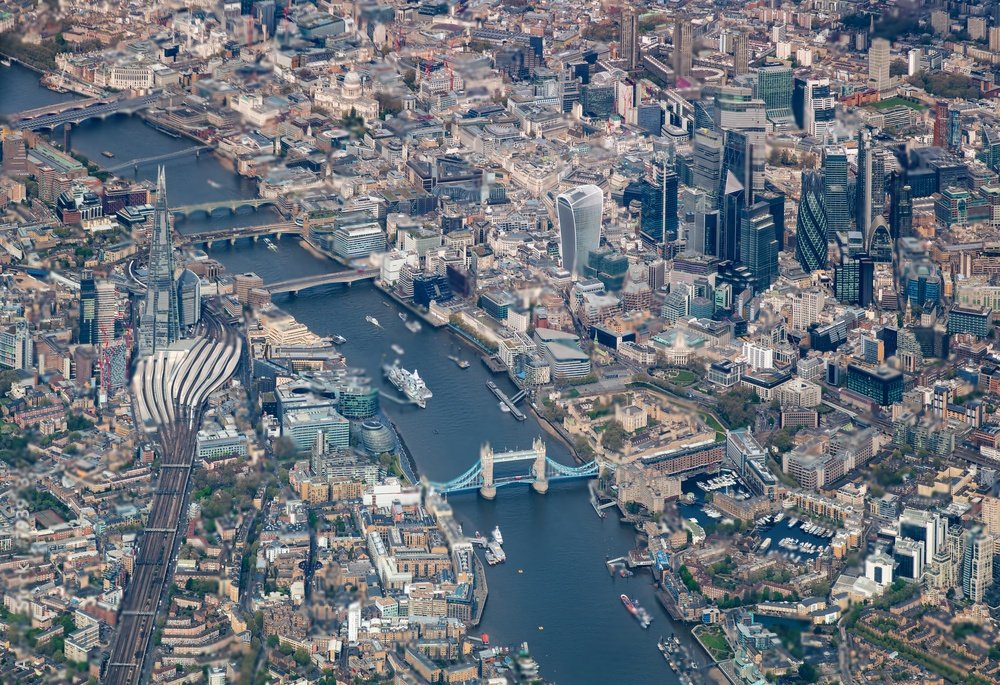The Rich History of the River Thames
The River Thames, meandering through the heart of England, holds within its waters the stories of the nation’s past and present, reflecting its journey from a wild force of nature to a thriving center of leisure activities.
Dive into the captivating history of the River Thames with this article, which takes you on a historical voyage through its transformation over the centuries. Discover its role as a vital trade route for the Romans, its impact on London’s politics, and its adaptation to the challenges of the Industrial Age. Explore how the river continues to thrive in contemporary times, serving as a bustling artery for activities and leisure.

A Prehistoric Powerhouse
Picture a moment in history millions of years in the past. The Thames wasn’t the calm river we see now. Back in the Ice Age, it was a massive force of nature, ten times larger than it is today. This enormous river cut through the Chiltern Hills, creating a lasting impact on the land. As the powerful ice sheets melted away, the Thames found its current path, shaping London and the area around it.
Roman Roots and the Birth of Londinium
In Roman times, the Thames became an important trade route, leading to the establishment of Londinium (modern-day London) by the Romans in 43 AD. This decision set the stage for London to become a major commercial hub. The Romans also constructed the first bridge across the river, a significant development in connecting the two banks and promoting trade.
Medieval Majesty
The River Thames remained a key point of interest after the Romans left, serving different purposes. Vikings utilized it to reach settlements along its banks, while the Anglo-Saxons constructed forts for defense against these invaders. Notably, the Thames played a crucial role in shaping London’s political landscape, with Westminster Abbey and the Tower of London marking the division between government and trade centers. This geographical separation, aided by the river, still influences London’s layout today.
Industrial Age and Beyond
The River Thames was bustling with activity during the Industrial Revolution, as ships from all over the world brought in cargo. It became a vital trade route for London, but the progress also led to pollution and industrial waste, harming the river’s health. Fortunately, there has been a growing awareness of the importance of environmental protection, leading to significant efforts to clean up the Thames and restore its vitality
The River Thames Today
Today, the River Thames is nothing like its industrial past. It’s now a bustling waterway running through the heart of London. A hotspot for relaxation, fun, and pleasure. Boat trips showcase breathtaking sights of the city’s iconic buildings, offering a unique perspective of London. Just imagine sailing past Big Ben, the Houses of Parliament, and the grand Tower of London, all while discovering the city’s fascinating history with a knowledgeable guide.
The depth of the River Thames varies, with depths ranging from approximately 11 meters (36 feet) in central London to a shallower 5 meters (16 feet) upstream. These fluctuations in depth are essential for different types of river traffic and are key to maintaining the health of the river ecosystem.
Planning Your Visit to the River Thames
There are numerous ways to experience the magic of the River Thames. Here’s a detailed guide to help you plan your visit:
- Embark on a Scenic Boat Tour: Many companies offer sightseeing trips on the Thames. These tours give you the chance to see famous landmarks like Big Ben and the Houses of Parliament from a unique vantage point. Tours run daily, with various departure times. Prices vary depending on the length and route of the tour, allowing you to select the option that suits your interests and budget.
- Explore the Thames Path: Attention all walkers and cyclists! If you haven’t already, you must check out the Thames Path. This designated national trail runs for more than 200 miles along the riverbank. It’s a picturesque route that lets you experience the Thames at your own speed. Discover secret spots, revel in the breathtaking views of the countryside, and lose yourself in the serenity of nature. The Thames Path is accessible year-round and free of charge, making it a great choice for budget-conscious travelers and nature enthusiasts.
- Immerse Yourself in the Thames Festival: Every September, the Thames Festival bursts with life as it celebrates the river’s rich heritage and culture. From live music to captivating performances, exciting boat races, and a range of family-friendly activities, there’s no shortage of fun. It’s the perfect chance to embrace the festive vibe, delve into the Thames’ importance, and create memories that will last a lifetime. With events happening across various locations along the river for several days, there’s bound to be something that appeals to everyone.

Further Exploration
For more information on specific aspects of your River Thames visit, here are some helpful resources:
- London Eye River Cruise: Check out the amazing views of London from the river on a scenic cruise provided by the London Eye. Visit their website to see all the different tour choices, compare prices, and secure your tickets early.https://www.londoneye.com/tickets-and-prices/river-cruise/
- The National Trail – Thames Path: Get ready for your walking or cycling journey along the Thames Path by checking out the official National Trail website. You can access detailed maps, learn about various sections of the path, and get helpful tips for a great adventure. https://www.nationaltrail.co.uk/en_GB/trails/thames-path/
- Thames Festival Trust: Get fully involved in the Thames Festival vibe by exploring the official website of the Thames Festival Trust. Stay up to date with all the latest info about the upcoming festival, such as event schedules, venue listings, and ways to volunteer. https://thamesfestivaltrust.org/
Poetry and Thames
Yes, the Thames River has been a source of inspiration for poets for centuries! Here are a few examples:
- Early Inspiration: Geoffrey Chaucer, known as the “father of English literature,” first mentioned the Thames as a “silver stream” in his unfinished poem “The Parliament of Fowls.” He also referred to it as reflecting the “merry year.”
- Romantic Views: The Romantic writers from the 18th and 19th centuries found the beauty of the Thames river to be especially captivating. William Wordsworth, in his poem “Lines written near Richmond, upon the Thames at Evening,” beautifully portrayed the peaceful feeling of the river at sunset. John Keats, in his incomplete work “On the Thames,” depicted the river’s shimmering path through the lush green meadows.
- A City’s Reflection: The Thames often mirrors London’s ever-changing essence. In “Morte d’Arthur,” Alfred, Lord Tennyson utilizes the river as a pathway for King Arthur’s final journey, symbolizing the city’s extensive history. T.S. Eliot, in “The Waste Land,” portrays the Thames as a representation of London’s spiritual emptiness during that period.
- A Place of Mystery: The river’s depths are also filled with fascination. Edmund Spenser, in his epic poem “The Faerie Queene,” mentions the Thames as a symbol of England’s power, but with a hint of hidden danger. Agatha Christie even used the river as a backdrop for a thrilling murder in her novel “The Murder on the Orient Express.”
The HMS Belfast:
The HMS Belfast has been through a lot. It was constructed in the 1930s and served in the Royal Navy during World War II, taking on Germany and supporting the Normandy landings. Just picture it battling other warships and safeguarding troop ships in the English Channel!
After the war, Belfast didn’t just fade away. It actually played a role in the Korean War. However, its days of fighting were numbered. Rather than being dismantled, a team of individuals came forward to preserve it. They understood that Belfast held significant historical value, serving as a tribute to the courageous individuals who once fought there.
In 1971, Belfast was transported to London and found a new residence on the River Thames, right beside the iconic Tower Bridge. It was transformed into a museum ship, allowing visitors to explore and discover what life was really like on a warship. It’s basically a massive time machine parked in the Thames!
The HMS Belfast is a must-see for tourists today. It’s a great way to step back in time, check out the massive guns, and wander through the tight quarters where sailors used to work and battle. It’s like a piece of history just floating on the River Thames.
Conclusion:
London’s ever-changing tale is anchored by the River Thames, a steadfast witness to the city’s metamorphosis. It intertwines centuries of history with its silent flow. So, when you’re in proximity to its waters, take a moment to acknowledge this historic river. Whether you choose to cruise along its currents, explore the scenic pathways lining its banks, or simply sit by the river and absorb the surroundings, the River Thames offers a distinct outlook on London, a chance to connect with the city’s bygone eras, its present reality, and its future possibilities.





